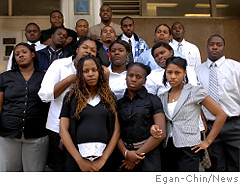 The Yale Club has Answered Robert Bork’s slip and fall personal injury case. Bork — the former SCOTUS nominee, conservative favorite and tort “reformer” — had sued the Yale Club for causing him to fall as he attempted to step up to the dais to give remarks. His federal suit, started in the Southern District of New York for “in excess of $1,000,000” plus punitive damages, has been met with widespread ridicule, as noted at the bottom of the post linked above. The then 79-year old former jurist claimed there should have been a step and/or handrail for him.
The Yale Club has Answered Robert Bork’s slip and fall personal injury case. Bork — the former SCOTUS nominee, conservative favorite and tort “reformer” — had sued the Yale Club for causing him to fall as he attempted to step up to the dais to give remarks. His federal suit, started in the Southern District of New York for “in excess of $1,000,000” plus punitive damages, has been met with widespread ridicule, as noted at the bottom of the post linked above. The then 79-year old former jurist claimed there should have been a step and/or handrail for him.
The Answer is here: YaleClubAnswer.pdf.
The Amended Complaint that it responds to is here:Bork Amends Lawsuit, Keeps Claim for Over $1,000,000 Plus Punitive Damages
With Yale now answering, Judge Bork is unable to voluntarily dismiss his case under FRCP 41 without prejudice and re-start it in New York Supreme Court, a more favorable venue as I discussed in What Should Bork Do Now?
To no great surprise, the Yale Club denies the allegations of negligence, specifically blames Judge Bork for the fall, claims the risks incident to “the situation” were open and obvious, and asserts that he has already received some remuneration for his economic loss.
Yale Club counsel is Eric Schnittman, who does not appear to have a website or much in the way of available information. New York’s court database lists him as a 1983 graduate of Fordham Law School.
The matter has been assigned to Judge Naomi Buchwald, appointed in 1999 by Pres. Clinton.
(Eric Turkewitz is a personal injury attorney in New York)



